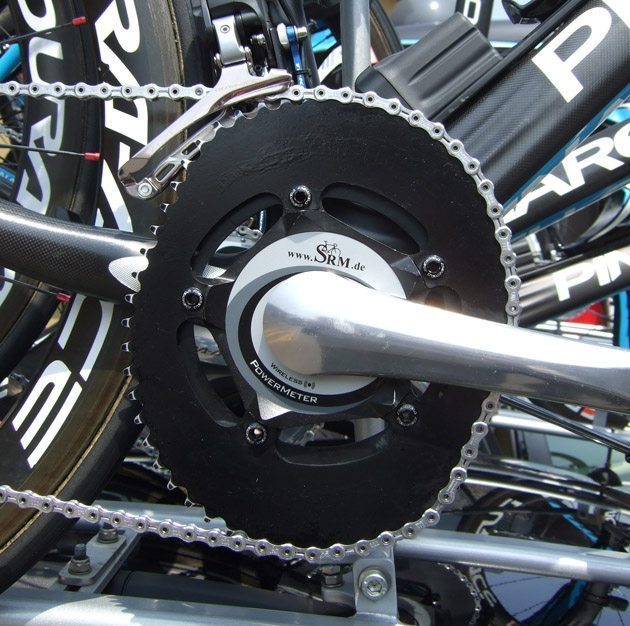Oval chainrings come good at the Tour de France
[wpcol_2third id=”” class=”” style=””]
Oval chainrings come good
They get top results in cycling’s top race
Posted 20 July 2012
Well, they’ll be taken more seriously now. With two stages remaining and the event’s mountain stages behind them, the top two riders on general classification in the 2012 Tour de France are both pedalling non-circular chainrings made by the French firm of O.Symetric.

A disguised O.Symetric chainring?
Non-circular chainrings have a long history dating back to the earliest days of the safety bicycle. Almost from the moment pedals turned the back wheel of a bicycle through the intervention of a chain, inventive types have tried to find a way around the perceived problem of the pedalling “dead spot” – the period with pedals at the top and bottom of the pedal stroke where it is hard, if not impossible, to apply significant turning force.
Non-circular ‘rings address this by speeding the feet through the dead spot and do this by reducing the effective diameter of the chainring at that point. Small ‘ring = low gear = fast cadence for a given road speed and sprocket size and, if the diameter of the chainring varies, so does the angular velocity of the cranks in proportion.
So, less time is spent with the legs unable to press effectively on the pedals, which must mean more time available to do the job properly. While there’s no question that this is what happens, results achieved using the ‘rings have not, until now, been sufficiently illustrious to dispel suspicions that they are more gimic than gain.
Top two placings in cycling’s biggest race for Bradley Wiggins and Chris Froome may well change this perception. After all, there’s nothing like major success to prove the validity of the claims made for the ‘rings.
O.Symetric’s examples are said by the manufacturer to elevate the rider’s “aerobic threshold” by 12percent and increase maximum aerobic power by 10percent. Other makers such as Rotor say their non-circular ‘rings do much the same. Supposing these are best-achievable figures, they are still impressive, especially if they represent a genuine improvement available to a cyclist competing at the highest level of the sport.
Here, the leading competitors are riding at what may be assumed to be approaching the limits of physical capacity; an advantage of just one percent is worth looking for, let alone 12.
Supposing this to be the level of improvement both Froome and Wiggins have gained by using O.Symetric rings, where would they be without them? There’s a widely-accepted figure for the maximum aerobic power the top riders can make: about six watts per kilogramme of body weight. It’s what educated calculations of the two Brits’ outputs based on rate of climb in the mountains would suggest. For a rider weighing 75kg, that means 450W; racing at 90percent of that – a good estimate of the leading riders’ “aerobic threshold” – gives 405W. If riding O.Symetric rings bumps that by 12percent, the rider makes 453W, or 6.04W/kg.
Alternatively, it could mean a 75kg rider making 405W at threshold would, on circular rings, only be able to manage a mere 361… In any case, the improvement is massively significant, especially as rate of climb on a steep slope is closely proportional to power output divided by body weight.
Perhaps it’s best not to worry about the possibility that Wiggins and Froome would not have been quite as dominant on circular rings; given that studies across the decades have concluded that alternative shapes, from oval to elliptical and back again and of varying “ovality”, offer no advantage and may, in some cases, have the opposite effect, it’s entirely possible that they would have gone as fast on regular rings. Although, no doubt, the Sky duo chose to ride O.Symetric rings for some good reason.
More to the point, perhaps, is that the UCI permits their use. Odd, this, since, for example, nobody may ride a UCI-sanctioned bike race with their kneecap vertically in front of the horizontal pedal axle in case they might gain some competitive advantage. The charitable explanation is, surely, that the Union’s technical experts did not believe the claims made for O.Symetric rings when in 1995 they authorised the company’s “Harmonic” chainring design for use in competition. They’d better believe them now.
[/wpcol_2third] [wpcol_1third_end id=”” class=”” style=””]
[hdp-ad 8]
[hdp-ad 9]
[hdp-ad 10]
[hdp-ad 11]
[hdp-ad 12]
[hdp-ad 13]
[hdp-ad 14]
[hdp-ad 15]
[/wpcol_1third_end]





